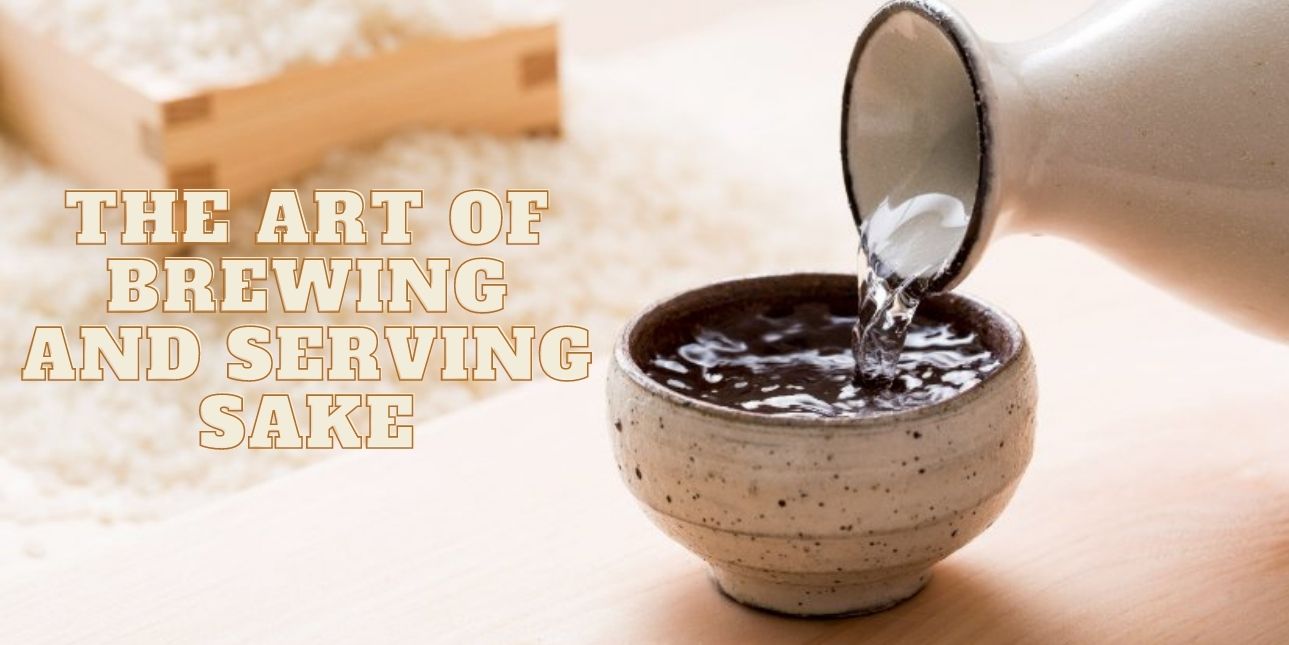
One of the most fascinating aspects of the drinking culture in Japan is that it focuses on building relationships, and is considered an effective way of breaking the ice. This culture is so common in the country that it even has its own term, called ‘nominication’, which means communication through drinking. Professionally, nominication is necessary to ensure a good working practice where the boss and the team go out for a drink after work. In such outings, ‘Sake’ is an important beverage for all.
What is Sake?
Sake, pronounced ‘sah-keh’, is a traditional rice beverage in Japan. Its unique aroma and taste are derived from fermented rice. The drink is light in color and has a sweet flavor. People often call sake wine because of its alcoholic content and appearance; however, it is produced by the fermentation of rice instead of grapes, in which the rice is converted from starch to sugar. The drink is also similar to wine in that they both undergo a fermentation process. Sake can also be compared to beer due to the use of grain and yeast for fermentation.
Known as ‘nihonshu’, or Japanese liquor, sake is the national beverage of the country and is served during special events, formal ceremonies, and national holidays. It is poured from ‘tokkuri’, a tall bottle, and drunk from a small porcelain cup called ‘sakazuki’. In this article, we delve deeper into the history, composition, and myths surrounding this quintessential drink.
History of Sake
According to reports, the production of sake first took place around 500 BC in China. The manufacturing process was not as refined as that of its modern counterpart. Villagers gathered to chew rice and nuts and expectorated the contents into a communal tub, which was stored for fermentation. The fermentation process was aided by the enzymes in their spittle. After the discovery of koji, a fungus used to saccharify rice, the method was discarded and the new brewing technique soon spread throughout Japan from CE 710 to 794, resulting in sake.
As brewing technologies and equipment improved during the 20th century, the production and quality of sake increased significantly. The drink accounted for almost 30 percent of Japan’s entire tax revenue around this time, compelling the government to ban home-brewed alcohol as it could not be taxed. Interestingly, it is still illegal to brew alcohol in Japan without a license. Today, the country has fewer than 2,000 sake breweries and the drink has gained popularity worldwide with breweries opening in China, Southeast Asia, Australia, and North and South America. Moreover, brewers celebrate 1st October every year as Sake Day. After knowing what it is, you must be wondering what is sake made out of.
What is Sake Made of?
The ingredients used for the brewing process include rice, yeast, water, koji, and the final drink contains 14 to 16 percent alcohol. What is sake drink’s composition and what is sake made from?
- The rice used is called ‘sakamai’, which is prepared through polishing.
- The water used has a different minerality that increases the speed of fermentation.
- Prefecture is used to develop the yeast, which contributes to the specific flavors and aromas of sake.
- Koji is distributed over the rice to convert the starches to sugar.
The Interesting Process of Brewing Sake
- The koji is mixed with fresh steamed rice and water and then wrapped in a blanket to form a sweet crumbly dry material.
- This is then placed in a vat with more water and rice.
- The mixture is allowed to ferment with yeast for about four weeks.
- In the second round of fermentation, more koji, steamed rice, and water are added to the vat, which lasts for seven days.
- After a week, the sake is filtered, pasteurized, and bottled.
How to Choose the Right Sake
If you are wondering how to choose the right sake, make sure to taste and test as many sakes as you would while choosing beer or wine.
- In a tasting cup called kiki-choko, take a small amount of sake and swirl it around your mouth. Once it reaches all of your tastebuds, breathe out slowly through your nose. You should test for acidic, sweet, dry, and bitter flavors, and then swallow or spit out the sake to test the aftertaste of the drink.
- The next step should be to check the appearance of the sake. To do that, fill kiki-choco with about 80 percent of sake and check the color and cloudiness of the liquid. The tasting cup usually has blue and white lines, and these should be visible if the sake is good. Older sake is dark in color while ordinary sake has a slightly amber or light yellow hue. You should also test the aroma of sake by bringing the tasting cup closer to your nose.
Japanese Traditions for Preparing Sake
Although knowing the basics of sake consumption suffice for you to enjoy the drink, certain traditions and manners such as how it is poured, how the cup is held, and the serving temperature play a critical role while drinking it. There are several sakes available to choose from, each prepared using different rice polishing techniques. Some of these include Junmai Daiginjo, Junmai, Junmai Ginjo, Tokubetsu Junmai, Nigori, Yamahai Junmai, Genshu, and Kimoto Junmai.
It is critical to note that every sake has different serving temperatures. For instance, Junmai is a versatile drink and can be served in a wide range of temperatures, whereas Junmai Ginjo is served chilled.
Sake can be served at room temperature, chilled, or hot, depending on the type of sake you prefer drinking. When it comes to drinking or serving the drink, you may wonder if it should be warm or cold. The most important thing to bear in mind is that there is rarely a right or wrong answer to such doubts.
Debunking the Myths Surrounding Sake
- One common myth is that sake is mostly or best served warm. The truth is many sakes taste even better when served chilled or at room temperature. While selecting a sake, it is wise to think about the environment, the food, the occasion, the people, and the serving style that fits the bill best. For instance, a hot sake tastes magical in cold or chilly winter months and is a great alternative for cider or mulled wine. The wonderful world of ‘kanzake’, or warming of sake, reveals the flavor and beauty of the drink. Warming sake reduces bitterness, opens up its aromas, and brings a sweetness to the taste that can be quite comforting.
- Another misconception is that the decision to warm sake is subject to the quality of the drink, that is, cheap sake is heated while the super-premium is enjoyed chilled. On the contrary, many Futsushu sakes can be served chilled, whereas premium ones such as ginjo and honjozo can be warmed before drinking.
How to Warm Sake
You do not have to be a professional at sake warming, however, remember to never overheat sake as that will lead to evaporation of alcohol. The boiling point of water is 212°F (100°C) and alcohol is 173°F (78.4°C), meaning alcohol evaporates before water. Experts recommend not to warm sake over 131°F (55°C) and a food-safe thermometer can aid in monitoring the temperature of the beverage. You can also use bar equipment to ensure your drink is at an ideal temperature.
This is how you can warm sake with the water bath method before serving:
- Fill the tokkuri with sake and make sure you leave about one inch of space from the top. Place the sake-filled container in a saucepan. The saucepan should be filled with water up to two-thirds of the tokkuri’s height. Take the tokkuri out of the pan after you have measured the water level.
- Boil the water.
- Put the tokkuri filled with sake in the boiled water.
- Check the desired temperature of the sake using a thermometer.
- Remove the tokkuri from the pan and dry it using a towel.
- Serve the tokkuri filled with hot sake.
Overboiling the sake or using a microwave oven to heat it can ruin the aroma and flavor of the drink.
Here are some tips for you to follow for serving cold sake or sake with ice:
- Take the chilled sake out of your fridge and pour it into a cold sake glass or white wine glass.
- You can also serve cold sake in a glass or tin carafe.
- In case you forget to place your drink in the refrigerator and your guests have arrived, you can use commercial ice makers.
You need to be cautious while freezing sake as too cold a drink can mask the flavor as it would do for wine.
How to Serve Sake Using the Japanese Culture
Regardless of the temperature, sake should be served using the etiquette of Japanese culture. Here are some methods:
- When the guest’s cup is less than one-third full, make sure you offer them a fresh pour.
- Hold the tokkuri with both hands and when the guest is ready, pour sake to the brim of the cup.
- Before receiving a fresh pour in your cup, finish the remaining sip. Once your cup is full, take a sip before putting it on the table.
- Pouring and receiving sake is a way of appreciating each other’s company. Therefore, ‘tejaku’, or the act of filling up your own cup, is considered impolite.
- Another way of serving sake is in a small box called masu. A glass cup can be placed in masu and sake can be poured with an intentional overflow of the drink. This serving style is called ‘sosogi koboshi’ and is a symbol of Japanese hospitality.
How to Drink Sake
After being served sake, it is also important to know how to drink it. Here are a few steps:
- Hold your drink with both hands.
- Wait until everyone has said ‘kanpai’, which is a way of saying cheers.
- Drink in small sips as sake is a strong drink.
- An open bottle of sake should be finished in three to four hours.
- Storing sake properly is important. If the bottle is not finished, store it in the refrigerator and finish it in a few days.
In conclusion, like other alcoholic beverages, sake is an intoxicant, however, its uniqueness lies in its rich and ancient ties to Japanese culture. While not as intense as vodka or rum, sake is stronger than most beers with an alcohol content of 15 percent. Given the varieties of sake available today, make sure to taste them all before choosing your preferred evening drink.














